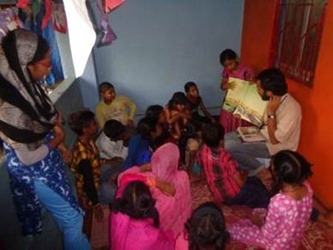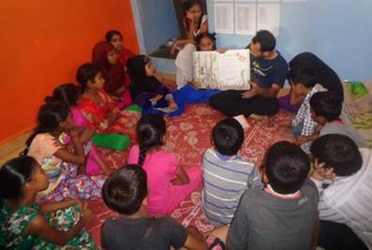This New Year, questions about how children could manage school, tuition classes, house chores and still manage to come to the library sessions, were at the back of my mind.
Would books more closely related to their school subjects, satisfy their conceptual needs for academics, as well as draw more children into the world of stories?
Why stories? Our stand has been that children who read stories (and read in general), are more likely to succeed in their school work, than those who do not read much.
Learning from an experiment
Galileo’s Leaning Tower Experiment a book written by Wendy Macdonald and Illustrated by Paolo Rui, was a new big book from the library, taken in the hope that the children would find a resonance between their school subjects and stories shared in the library sessions.
About the story: When the great scientist and professor Galileo meets a bright farm boy, Massimo, the teacher becomes the student.
On an ordinary day, Galileo encounters Massimo dropping food from a bridge to his uncle passing below in his boat. This simple action makes Galileo rethink Aristotle’s teachings. Galileo takes an interest in Massimo’s cleverness, and together, in a series of experiments, the two investigate the science of motion.
They then arrive at a conclusion that changes the course modern science!
Junaid, a new child at the library was asking a lot of questions, taking off from the discussion during the Read Aloud session on how air and wind can affect a falling object in the Earth’s atmosphere. He wanted to know how airplanes do not fall, as they do not flap their wings.
So the children had an outlet to all their questions after the story, where they were asked to pour out all their questions on paper and they did.
Why leaves are green or the sky blue?
Why man does not fly and why China’s wall is the largest?
Why we cannot rub pen marks like pencil?
Why is the sun yellow and why does a ball bounce?
Why the stars are white? How fish breathe in water? Why we need a fan?
Muskan, a senior library member had a series of 12 questions about life and its various aspects.
This session gave us an opportunity to bring the new non-fiction reference section of our library into action. Children were urged to use the material in that section to explore their questions.
Nurturing a questioning mind
The ‘Why Why Girl’ Moyna, a story character, motivated the children towards the reference shelf, in a session that followed after a couple of weeks. As she discovers through the author Mahasweta Devi, that books can lead to answers.
About the story: Moyna lives in a little tribal village. She cannot go to school because she has to tend the goats, collect the firewood and fetch the water… But she is so full of questions that the postmaster calls her the ‘why-why girl’!
Mahasweta Devi is one of India’s foremost writers. In this delightful story, her first picture book and the only children’s book she has written in English, she tells us how she meets Moyna (and her mongoose!) and helps her find answers to all the why-whys in books that Moyna herself learns to read.
Taking the children to the reference shelf after the Read Aloud, we asked them to frame questions on facts from these books. After introducing them to how a contents page works and a trial on framing questions, we let them explore.
As the children engaged with the heavy reference books, they seemed to find this question framing exercise very interesting.
They read a part of the book and framed a question and culled out the answer with the reference book name and page number of the topic below it.
Then perhaps the answer to the question raised in the first line of this blog, is a question itself:
Why should the children miss out this opportunity of a library, a door to many worlds, right within their community?




